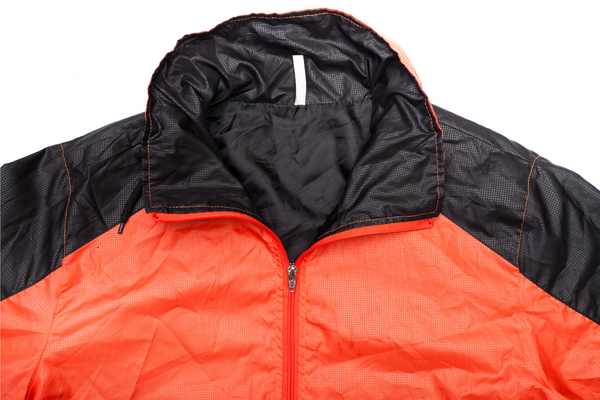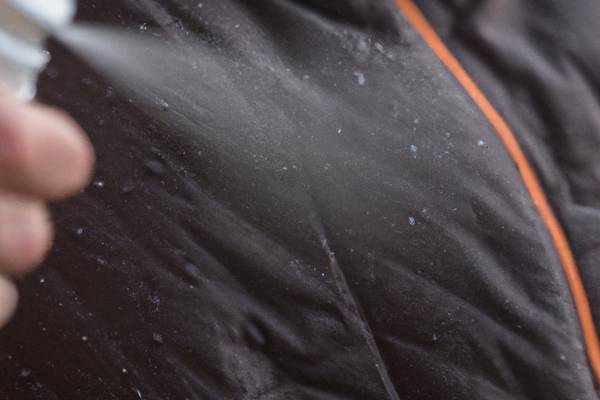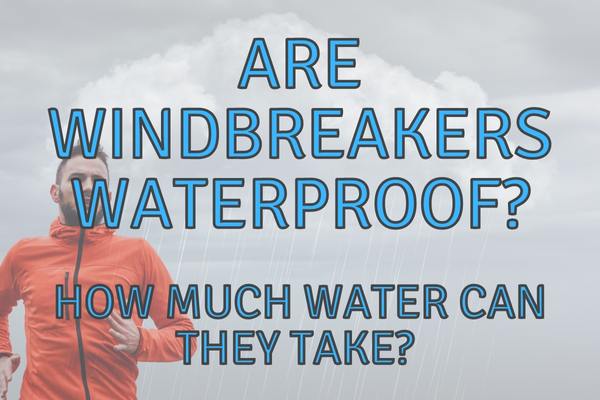Windbreakers are an essential piece of gear for any hiker or outdoor enthusiast. They can protect you from the wind and keep you warm, but they’re not always suitable in wet weather conditions.
No, windbreakers are not waterproof. Windbreakers are designed to protect you from wind and slightly chilly temperatures, but they are not typically made from waterproof materials.
Because the main difference between a rain jacket and a windbreaker is the ability to keep water out, a windbreaker can never be fully waterproof as this would make it a rain jacket!
Windbreakers are often made from lightweight and breathable materials, such as nylon or polyester, which can provide some protection from light rain or drizzle.
However, in heavy rain, a windbreaker will not keep you dry. If you need protection from rain, a rain jacket is a better choice.
In this blog post we will explore what a windbreaker is, its ability to resist water, how it differs from rain jackets and ultimately help guide your decision on whether to buy a rain jacket or a windbreaker for your next hike.
Windbreakers may seem like just another layer of clothing when venturing out into nature but understanding their unique properties can be the difference between staying dry and being drenched!
Contents
What is a Windbreaker?
A windbreaker is a lightweight, breathable jacket designed to protect against wind and light rain. It typically has a hood, drawstrings, and elastic cuffs to keep the wind out.
Windbreakers are usually made of nylon or polyester fabrics that have been treated with water-resistant coatings. This makes them perfect for outdoor activities such as hiking, camping, running, biking, and other activities where you may be exposed to the elements.
Windbreakers offer protection from the wind but they are not waterproof like rain jackets or parkas. They can help keep you warm by blocking out cold air while still allowing your body heat to escape so you don’t overheat during physical activity.

The fabric used in most windbreakers is also lightweight which makes it easy to pack away when not in use without taking up too much space in your bag or backpack.
Some windbreakers are water resistant, especially those made from nylon, meaning they will provide some protection from light rain but won’t hold up if there’s heavy downpour for an extended period of time.
If you plan on being outdoors for long periods of time in wet weather conditions then it’s best to invest in a waterproof rain jacket instead of relying solely on a windbreaker for protection from the elements.
The main purpose of a windbreaker is really just to block out strong winds and provide warmth without making you sweat too much.
Due its thin design, its breathability allows air flow through the material even when zipped up completely closed at all times keeping you comfortable throughout any activity outdoors no matter what type of weather conditions arise unexpectedly .
When deciding between buying either a rain jacket or a windbreaker, consider how often you plan on using each item based on what kind of climate your area experiences most frequently throughout the year.
This is because one might be more practical than another depending on those factors alone. For example, if your area experiences mostly dry climates with occasional rainfall then investing into both items would make sense.
Having both gives versatility options when choosing appropriate clothing depending upon whatever Mother Nature throws at you next!
Key Takeaway:
A windbreaker is a lightweight and breathable garment that provides protection against the elements, making it an essential piece of gear for hikers and outdoor enthusiasts.
A windbreaker is lightweight and breathable – Not waterproof like rain jacket/sparkas – Great for outdoor activities – Provides warmth without sweating excessively – Consider climate when deciding between buying either
Is A Windbreaker Good Enough for Rain?
Windbreakers are a popular choice for outdoor enthusiasts, especially hikers. They’re lightweight and easy to pack, but they don’t offer the same level of protection as rain jackets or ponchos. Windbreakers are designed primarily to block wind and provide some warmth in cool weather conditions, not to keep you dry in wet weather.

While some windbreakers may be water resistant, they aren’t waterproof like a rain jacket or poncho is.
Windbreakers are usually made from nylon or polyester, and most often waterproof nylon fabrics will be a blend of more than one polymer and typically a waterproof layer is applied on top.
Depending on how thick the nylon in question is, there will be some leakage of water through the fabric when the “hydrostatic pressure” reaches the breakpoint for that fabric.
A typical windbreaker is made from 20D nylon or an equivalent polyester fabric, will be able to withstand a maximum of 4000mm hydrostatic pressure if optimally waterproofed with silicon or DWR.
This is equivalent to lasting about half an hour in moderate rainfall.
Below is a table showing the approximate breakpoint hydrostatic pressure values for different nylon fabrics:
| Material | Grams/1000m thread | Avg. Fabric density | Water resistance (Hydrostatic Head) |
| 7D Nylon | 0.8 | 19 g/m² | 1000-2000mm |
| 10D Nylon | 1.1 | 25 g/m² | 1000-2000mm |
| 15D Nylon | 1.7 | 30 g/m² | 2000mm |
| 20D Nylon | 2.2 | 34 g/m² | 3000-4000mm |
| 30D Nylon | 3.3 | 47 g/m² | 4000-5000mm |
| 40D Nylon | 4.4 | 54 g/m² | 5000mmm |
| 210D Nylon | 23.3 | 70 g/m² | 15000mm |
| 400D | 44.4 | 100 g/m² | 20000mm |
Differences between the thinner nylon fabrics. The waterproof ratings are with appropriate treatments used in lightweight tents e.g. silicon.
Nylon can be made virtually waterproof if treated with a layer of silicon or PU (polyurethane) to make sure that no water gets through. This is often used in rain pants other rain gear.
This means that if you’re caught in light rain showers or occasional drips, your windbreaker will likely protect you from getting soaked – but it won’t stand up against heavy downpours.
If you plan on being out in the elements for extended periods of time during inclement weather, then it’s best to invest in something more protective than just a windbreaker.
When comparing a windbreaker with other types of outerwear such as rain jackets and ponchos there are several key differences:
Material: Windbreakers are usually made from nylon or polyester fabric which is lightweight and breathable but doesn’t offer much protection from moisture; whereas rain jackets and ponchos use materials such as Gore-Tex or plain plastic, which offers superior waterproofing capabilities while still allowing air flow through the material so that sweat can escape easily.
Design: Windbreakers typically have zippers running along the front of them so that they can be opened up when needed; however this also allows cold air to enter inside making them less effective at keeping warm compared to zip-up designs found on most ponchos, which trap heat better due to their snug fit around your body.
Weight & Packability: Because of their thin construction, windbreakers weigh significantly less than other forms of outerwear such as raincoats/jackets (which tend to be heavier due its thicker material) meaning they take up far less space when packing them away into backpacks etc., making them ideal for carrying around on hikes where weight is an important factor when considering what type of clothing items should be taken with you on any given trip outdoors.
In conclusion, while a windbreaker may provide some level of protection against light rainfall, it is not suitable for prolonged exposure during heavy downpours since its main purpose is to block out strong winds rather than providing full coverage against precipitation like what would come with dedicated waterproof garments such as rain coats or jackets.
Therefore, if you are looking for reliable all-weather gear then investing in one of these options might make more sense depending on how often you find yourself exposed outdoors during wetter climates.
A windbreaker can be a great addition to your outdoor wardrobe when it comes to protecting yourself from the rain. However, depending on the fabric and design, some may not provide enough coverage or protection against heavy downpours. Next up, we’ll look at how windbreakers can help keep you warm in cold weather.
Key Takeaway: A windbreaker is a great choice for hikers looking to stay warm and protected from strong winds, but it may not provide enough protection against wet weather. Windbreakers are lightweight and breathable, but they should be compared with rain jackets or ponchos which offer superior waterproofing capabilities.
Are Any Windbreakers Waterproof?
No, windbreakers offer lightweight protection from wind and rain while keeping you comfortable in the outdoors.
But what many people don’t realize is that windbreakers are not waterproof – they are only water resistant – otherwise they would be rain jackets!
A windbreaker is designed to block out strong winds and keep you warm on cold days, but it won’t keep you dry in heavy downpours or prolonged exposure to water.
The fabric of a windbreaker is usually made of nylon or polyester which can repel light rain or mist, but will eventually become saturated if exposed to too much moisture.
When shopping for a new jacket, it’s important to understand the difference between waterproof and water-resistant fabrics so that you can make an informed decision about which type of jacket best suits your needs.

Waterproof jackets have sealed seams that prevent any moisture from entering through the fabric; whereas water-resistant jackets may allow some moisture through their seams when exposed to extended periods of wet weather conditions.
Rain jackets are specifically designed with waterproof materials such as Gore-Tex® or eVent® which provide superior protection against heavy rains and other wet weather conditions compared to a regular windbreaker jacket.
Rain jackets also typically feature hoods with drawstrings for added coverage around your head and face during inclement weather conditions as well as adjustable cuffs at the wrists for extra protection against rain dripping down your arms into your sleeves.
It really depends on how often you plan on being outside in wet weather conditions and what kind of activities you plan on doing while wearing either one of these types of outerwear garments.
If you want something lightweight yet still provides good coverage against light rains, then go with a windbreaker; however, if frequent rainy days are expected, then opt for the more durable option –a rain jacket– instead since it offers better overall protection from heavier downpours than its lighter counterpart does.
Windbreakers are a great way to protect yourself from the wind, but it is important to understand if they are waterproof or not. Next we will discuss how to choose the right windbreaker for your needs.
Key Takeaway: When choosing an outerwear garment for outdoor activities, it’s important to consider the weather conditions you’ll be facing. Windbreakers are lightweight and offer protection from wind and light rain but are not waterproof.
Some windbreakers are more water resistant than others
While usually made from synthetic fabrics such as nylon or polyester, which are resistant to water but not waterproof, windbreakers do differ in their water resistance. While they may offer some protection against the elements, they should not be relied upon in heavy rain or wet conditions.
Water Resistance: Windbreakers typically feature a DWR (durable water repellent) coating on the fabric that helps keep out light moisture. This coating is applied during manufacturing and can wear off over time with regular use and washing.

It’s important to note that while this coating makes the fabric more resistant to water, it does not make it waterproof.
Taped Seams: Some windbreakers also feature taped seams for added protection against moisture seeping through any small gaps between panels of fabric used in construction of the jacket. Taped seams provide an extra layer of defense against light rain but will still allow some moisture through if exposed to heavy downpours or long periods of exposure in wet weather conditions.
Zippers: Many windbreaker styles include zippers with waterproof coatings on them for additional protection from moisture entering through openings such as pockets or vents when closed up tight enough.

These zippers help keep out most water droplets, however they too can let some moisture pass through if exposed to heavier rains or prolonged wet weather conditions.
Overall, windbreakers offer some resistance to both wind and light rain due to their lightweight materials and features such as taped seams and waterproof zippers.
However, they should not be relied upon as a full-on solution for keeping one dry in all types of weather conditions; especially those involving heavy downpours or extended periods outdoors in wet environments where a fully waterproof jacket would be more suitable.
Windbreakers are a great choice for outdoor activities, especially when it comes to staying dry in wet weather. They provide excellent protection against wind and rain while still allowing air circulation. Now let’s look at how to choose the right windbreaker for your needs.
Key Takeaway: Windbreakers are lightweight jackets designed to protect against wind and light rain, usually made from synthetic fabrics such as nylon or polyester. They offer some protection due to features like DWR coating, taped seams and waterproof zippers but should not be relied upon in heavy rain or wet conditions.
Can a Windbreaker be Used as a Raincoat?
They are lightweight, comfortable, and provide protection from the wind. But what about rain? Can a windbreaker be used as a raincoat?
The short answer is no. Windbreakers are designed to block out the wind, not keep you dry in heavy downpours or prolonged exposure to water. While some may offer some protection from light rain or mist, they will not keep you completely dry in wet conditions.
When it comes to waterproofing your clothing against the elements, there is an important distinction between water resistant and waterproof fabrics.
Water resistant fabrics can repel small amounts of liquid but eventually become saturated with moisture if exposed for too long; whereas waterproof materials will remain impermeable even when submerged in water for extended periods of time.

Most windbreakers use water-resistant fabric which means that while they can handle light showers or brief periods of exposure to moisture, they won’t protect you from heavy rains or standing puddles of water on trails and paths like a true waterproof material would do.
So should you buy a rain jacket instead? Rain jackets come with several advantages over their lighter counterparts: firstly, most feature fully sealed seams that prevent any moisture from seeping through; secondly, many models come equipped with hoods that further shield your head and face from the elements; thirdly—and perhaps most importantly—rain jackets tend to be made using thicker materials than windbreakers so they offer more insulation during cold weather hikes (which is especially useful if you plan on camping overnight).
Ultimately, it depends on how much protection you need against inclement weather conditions. If all you require is something lightweight enough for summer hikes, then go ahead and get yourself a good quality windbreaker. However, if winter hiking trips are part of your plans, then investing in an appropriate rain jacket might be worth considering too.
Although a windbreaker may not be as waterproof as a raincoat, it can still provide protection from light rain and windy conditions. In addition to its use in wet weather, let’s explore the other benefits of owning a windbreaker.
Key Takeaway: Windbreakers provide lightweight protection from the wind, but they are not suitable for heavy rain or prolonged exposure to water. Rain jackets offer a better option as they feature sealed seams and thicker materials that can keep you dry and insulated during cold weather hikes. When deciding between the two, consider how much protection you need against inclement weather conditions and what activities you plan on doing outdoors.
How can I make my windbreaker more water resistant?
There are a few steps you can take to make your windbreaker more water-resistant. Here is a simple guide on how to do it:
- Start by cleaning your windbreaker. Remove any dirt, debris, or stains from the surface of the jacket using a mild detergent and warm water. Be sure to rinse the jacket thoroughly and let it air dry completely before proceeding to the next step.
- Once your windbreaker is clean and dry, you can apply a waterproofing spray to the surface of the jacket. This will add a layer of water-repellent protection to the fabric and help it shed water more effectively.
Be sure to read and follow the instructions on the spray carefully, and apply it evenly over the entire surface of the jacket. - After applying the waterproofing spray, allow the jacket to dry completely. This may take several hours or overnight, depending on the specific spray and the humidity in your area. Once the jacket is dry, it should be more water-resistant than it was before.
- If your windbreaker has any seams, you can also apply seam sealer to the inside of the jacket. Seam sealer is a waterproof adhesive that is applied to the seams of the jacket to prevent water from entering through the stitching.
To apply seam sealer, follow the instructions on the product carefully and apply a thin layer of sealer to the inside of each seam. Be sure to let the sealer dry completely before wearing the jacket. - After applying the seam sealer, your windbreaker should be more water-resistant than it was before. To maintain its water-resistant properties, be sure to clean and re-waterproof the jacket regularly, according to the instructions on the products you are using.
This will help to keep your windbreaker in good condition and provide the best possible protection against rain and wet weather.
That’s it! But remember that your windbreaker will never be completely waterproof like a real rain jacket.
Differences between windbreakers and rain jackets
Windbreakers and rain jackets are two of the most popular pieces of outdoor apparel, but they serve very different purposes. Windbreakers are lightweight garments designed to protect against wind and light precipitation.
They usually have a hood, long sleeves, and a drawstring waistband for added protection from the elements. Rain jackets are heavier garments made with materials or shells (such as GoreTex or HyVent) that are actually waterproof and more windproof than windbreakers.

When it comes to cost, windbreakers tend to be cheaper than rain jackets because they’re made with lighter fabrics that don’t offer as much protection from the elements. On the other hand, rain jackets can be quite expensive due to their superior waterproofing capabilities.
In terms of weight, windbreakers tend to be much lighter than rain jackets since they use thinner fabric that is not meant for heavy-duty wear in wet conditions. This makes them ideal for hikers who want something lightweight yet still protective enough against strong winds or light showers while out on the trail.
When it comes to snowfall, a windbreaker may be able to keep you dry for longer as the snow won’t necessarily melt on the surface, but it will require numerous layers underneath to keep you warm!

This means that if you plan on spending extended amounts of time outdoors in wet climates then investing in a proper rain jacket is essential!
It really depends on your individual needs – if you are looking for something lightweight and inexpensive, then go with a windbreaker. However, if you need something more durable and reliable when faced with extreme weather conditions, then invest in a good quality rain jacket instead.
Windbreakers are designed to protect you from wind and light rain, while rain jackets are designed for more extreme weather conditions. Next, we’ll explore the features of each type of garment to help you decide which one is best for your needs.
Key Takeaway: Windbreakers and rain jackets serve very different purposes, so it’s important to choose the right one for your needs. Windbreakers are lightweight garments designed to protect against wind and light precipitation but won’t provide complete waterproofing in heavy rains or snowstorms. Rain jackets offer superior waterproofing capabilities but tend to be more expensive due to their materials or shells (such as GoreTex or HyVent). Consider factors such as cost, weight, protection from the elements when making a decision on which type of outerwear is best for you.
Should I buy a rain jacket or a windbreaker?
When it comes to outdoor activities, having the right gear is essential. Whether you’re a hiker, camper or just an outdoor enthusiast, you need clothing that can protect you from the elements. Windbreakers and rain jackets are two popular items of outerwear that offer protection from wind and rain respectively. But which one should you buy?
It depends on your needs and the weather conditions you will be facing. A rain jacket is designed to keep you dry in wet weather, while a windbreaker is designed to protect you from wind and chilly temperatures. Here are some pros and cons of each:
Rain jacket:
- Pros:
- Will keep you dry in wet weather
- Often made from waterproof materials that won’t let rain through
- Cons:
- May not be as breathable as a windbreaker, which can make you feel hot and sweaty in warmer weather
- Can be more expensive than a windbreaker
Windbreaker:
- Pros:
- Can protect you from wind and chilly temperatures
- Often made from lightweight, breathable materials that won’t make you feel too hot
- Cons:
- May not be as waterproof as a rain jacket, so you may still get wet in heavy rain
- Can be less durable than a rain jacket, so it may not last as long
Ultimately, the best choice for you will depend on your specific needs and the weather conditions you will be facing. If you need to stay dry in wet weather, a rain jacket is the better choice. If you need protection from wind and chilly temperatures, a windbreaker may be the better option.
Rain jackets and windbreakers both have their advantages when it comes to outdoor activities, so it’s important to consider your needs before deciding which one is best for you. Now let’s take a look at the features of each type of jacket.
Key Takeaway: A windbreaker is a lightweight jacket designed to provide protection against wind chill and light precipitation. It is not waterproof, so it cannot protect from heavy downpours. However, some newer models may be more resistant than others with special coatings or materials such as polyurethane (PU) coating or DWR (durable water repellent). When buying a windbreaker for rain, it’s important to check the product description first.
FAQs
In what weather can you wear a windbreaker?
You can wear a windbreaker in a variety of weather conditions, but it is most effective in cool and windy conditions. Windbreakers are designed to protect you from wind and chilly temperatures, so they are a good choice for cool, windy days. They are also often made from lightweight and breathable materials, which can make them a good choice for warmer weather as well, as long as there is no rain.
However, as mentioned earlier, windbreakers are not usually waterproof, so they may not be the best choice for wet weather. If you need protection from rain, a rain jacket is a better choice. If you need to stay warm in cold weather, a heavier jacket such as a parka or a coat may be a better option. It ultimately depends on the specific weather conditions and your personal preferences.
Can I use a windbreaker in the rain?
It depends on the specific windbreaker and the weather conditions you will be facing. Some windbreakers may provide some protection from light rain or drizzle, but they are not usually made from waterproof materials. This means that they may not keep you dry in heavy rain or wet weather. If you need to stay dry in the rain, a rain jacket is a better choice.
Can you get a windbreaker wet?
Yes, you can get a windbreaker wet. Windbreakers are not usually made from waterproof materials, so they will not keep you dry in heavy rain. However, they are often made from water-resistant materials that can provide some protection from light rain or drizzle.
If your windbreaker gets wet, it will depend on the material and construction of the jacket as to how it will behave. Some windbreakers may become heavy and uncomfortable when wet, while others may retain their shape and continue to provide some protection from wind and chilly temperatures. In general, however, a windbreaker is not the best choice for wet weather.
Are nylon windbreakers waterproof?
It depends on the specific windbreaker and the materials and construction used to make it. Some nylon windbreakers may be waterproof, while others may not be.
Nylon is a synthetic material that is known for its strength and durability. It is often used in outdoor clothing, including windbreakers, because it is lightweight, breathable, and water-resistant. However, not all nylon windbreakers are waterproof. In order to be waterproof, a windbreaker would need to be made from a waterproof material, such as Gore-Tex, and be seam-sealed to prevent water from entering through the seams.
If you need a windbreaker that is waterproof, it is best to look for one that is specifically designed and marketed as waterproof. You can also look for windbreakers made from waterproof materials, such as Gore-Tex, and check to see if they are seam-sealed. This will give you the best chance of finding a windbreaker that will keep you dry in wet weather.
Conclusion
In conclusion, windbreakers are great for blocking out the wind and providing warmth in cooler temperatures. However, they are not waterproof or water resistant enough to provide protection from rain. If you’re looking for a jacket that will keep you dry during wet weather conditions, then a rain jacket is your best bet.
While both jackets have their own unique benefits, it’s important to consider what type of activity you’ll be doing before making your purchase so that you can choose the right one for your needs. Windbreakers may be more lightweight and breathable than rain jackets but if you need something to protect against the elements then a rain jacket is definitely the way to go!





